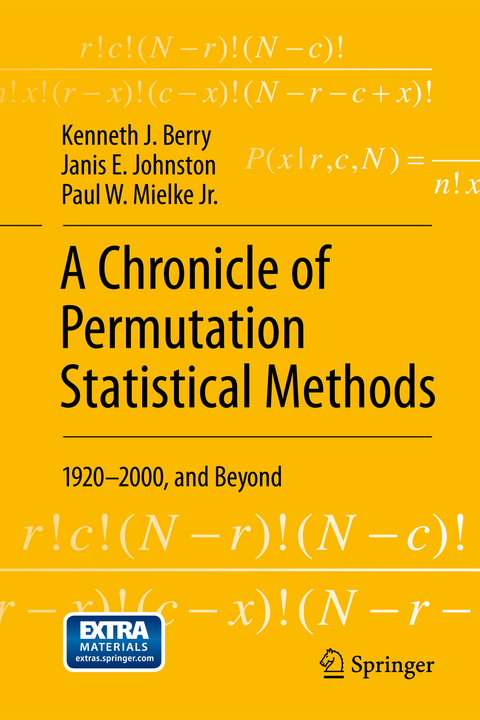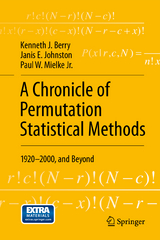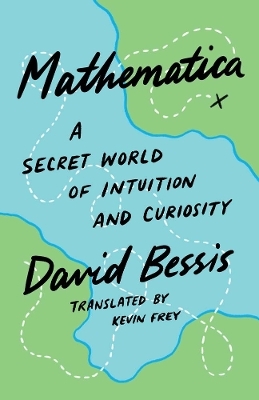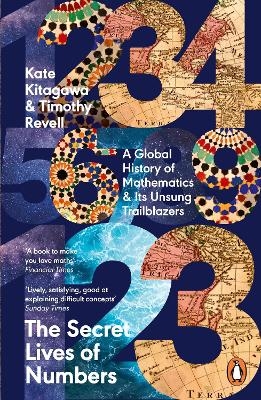A Chronicle of Permutation Statistical Methods
Springer International Publishing (Verlag)
978-3-319-02743-2 (ISBN)
The focus of this book is on the birth and historical development of permutation statistical methods from the early 1920s to the near present. Beginning with the seminal contributions of R.A. Fisher, E.J.G. Pitman, and others in the 1920s and 1930s, permutation statistical methods were initially introduced to validate the assumptions of classical statistical methods.
Permutation methods have advantages over classical methods in that they are optimal for small data sets and non-random samples, are data-dependent, and are free of distributional assumptions. Permutation probability values may be exact, or estimated via moment- or resampling-approximation procedures. Because permutation methods are inherently computationally-intensive, the evolution of computers and computing technology that made modern permutation methods possible accompanies the historical narrative.
Permutation analogs of many well-known statistical tests are presented in a historical context, including multiple correlation and regression, analysis of variance, contingency table analysis, and measures of association and agreement. A non-mathematical approach makes the text accessible to readers of all levels.
Kenneth J. Berry is Professor of Sociology at Colorado State University.Janis E. Johnston is a Social Science Policy Analyst with the United States government in Washington, D.C. Paul W. Mielke, Jr. is Professor Emeritus of Statistics at Colorado State University and Fellow of the American Statistical Association.
lt;p>Preface.- 1.Introduction.- 2.1920-1939.- 2.1.Overview of Chapter 2.- 2.2.Neyman-Fisher-Geary and the Beginning.- 2.3.Fisher and the Variance-ratio Statistic.- 2.4.Eden-Yates and Non-normal Data.- 2.5.Fisher and 2 by 2 Contingency Tables.- 2.6 Yates and the Chi-squared Test for Small Samples.- 2.7.Irwin and Fourfold Contingency Tables.- 2.8.The Rothamsted Manorial Estate.- 2.9.Fisher and the Analysis of Darwin's Zea mays Data.- 2.10.Fisher and the Coefficient of Racial Likeness.- 2.11.Hotelling-Pabst and Simple Bivariate Correlation.- 2.12.Friedman and Analysis of Variance for Ranks.- 2.13.Welch's Randomized Blocks and Latin Squares.- 2.14.Egon Pearson on Randomization.- 2.15.Pitman and Three Seminal Articles.- 2.16.Welch and the Correlation Ratio.- 2.17.Olds and Rank-order Correlation.- 2.18.Kendall and Rank Correlation.- 2.19.McCarthy and Randomized Blocks.- 2.20.Computing and Calculators.- 2.21.Looking Ahead.- 3.1940-1959.- 3.1.Overview of Chapter 3.- 3.2.Development of Computing.- 3.3.Kendall-Babington Smith and Paired Comparisons.- 3.4.Dixon and a Two-sample Rank Test.- 3.5.Swed-Eisenhart and Tables for the Runs Test.- 3.6.Scheff´e and Non-parametric Statistical Inference.- 3.7.Wald-Wolfowitz and Serial Correlation.- 3.8.Mann and a Test of Randomness Against Trend.- 3.9.Barnard and 2 by 2 Contingency Tables.- 3.10.Wilcoxon and the Two-sample Rank-sum Test.- 3.11.Festinger and the Two-sample Rank-sum Test.- 3.12.Mann-Whitney and a Two-sample Rank-sum Test.- 3.13.Whitfield and a Measure of Ranked Correlation.- 3.14.Olmstead-Tukey and the Quadrant-sum Test.- 3.15.Haldane-Smith and a Test for Birth-order Effects.- 3.16.Finney and the Fisher-Yates Test for 2 by 2 Tables.- 3.17.Lehmann-Stein and Non-parametric Tests.- 3.18 Rank-order Statistics.- 3.19.van der Reyden and a Two-sample Rank-sum Test.-3.20.White and Tables for the Rank-sum Test.- 3.21.Other Results for the Two-sample Rank-sum Test.- 3.22.David-Kendall-Stuart and Rank-order Correlation.- 3.23.Freeman-Halton and an Exact Test of Contingency.- 3.24.Kruskal-Wallis and the C-sample Rank-sum Test.- 3.25.Box-Andersen and Permutation Theory.- 3.26.Leslie and Small Contingency Tables.- 3.27.A Two-sample Rank Test for Dispersion.- 3.28.Dwass and Modified Randomization Tests.- 3.29.Looking Ahead.- 4.1960-1979.- 4.1.Overview of Chapter 4.- 4.2.Development of Computing.- 4.3 Permutation Algorithms and Programs.- 4.4.Ghent and the Fisher-Yates Exact Test.- 4.5.Programs for Contingency Table Analysis.- 4.6.Siegel-Tukey and Tables for the Test of Variability.- 4.7 .Other Tables of Critical Values.- 4.8.Edgington and Randomization Tests.- 4.9.The Matrix Occupancy Problem.- 4.10.Kempthorne and Experimental Inference.- 4.11.Baker-Collier and Permutation F Tests 4.12.Permutation Tests in the 1970s.- 4.13.Feinstein and Randomization.- 4.14.The Mann-Whitney, Pitman, and Cochran Tests.- 4.15.Mielke-Berry-Johnson and MRPP.- 4.16.Determining the Number of Contingency Tables.- 4.17.Soms and the Fisher Exact Permutation Test.- 4.18.Baker-Hubert and Ordering Theory.- 4.19.Green and Two Permutation Tests for Location.- 4.20.Agresti-Wackerly-Boyett and Approximate Tests.- 4.21.Boyett and Random R by C Tables.- 4.22.Looking Ahead.- 5.1980-2000.- 5.1.Overview of Chapter 5.- 5.2.Development of Computing.- 5.3.Permutation Methods and Contingency Tables.- 5.4.Yates and 2 by 2 Contingency Tables.- 5.5.Mehta-Patel and a Network Algorithm.- 5.6.MRPP and the Pearson type III Distribution.- 5.7.MRPP and Commensuration.- 5.8.Tukey and Re randomization.- 5.9.Matched-pairs Permutation Analysis.- 5.10.Subroutine PERMUT.- 5.11.Moment Approximations and the F Test.- 5.12.Mielke-Iyer and MRBP.- 5.13.Relationships of MRBP to Other Tests.- 5.14.Kappa and the Measurement of Agreement.- 5.15.Basu and the Fisher Randomization Test.- 5.16.Still-White and Permutation Analysis of Variance.- 5.17.Walters and the Utility of Resampling Methods.- 5.18.Conover-Iman and Rank Transformations.- 5.19.Green and Randomization Tests.- 5.20.Gabriel-Hall and Re randomization Inference.- 5.21.Pagano-Tritchler and Polynomial-time Algorithms.- 5.22.Welch and a Median Permutation Test.- 5.23.Boik and the Fisher-Pitman Permutation Test.- 5.24.Mielke-Yao Empirical Coverage Tests.- 5.25.Randomization in Clinical Trials.- 5.26.The Period From 1990 to 2000.- 5.27.Algorithms and Programs.- 5.28.Page-Brin and Google.- 5.29.Spino-Pagano and Trimmed/Winsorized Means.- 5.30.May-Hunter and Advantages of Permutation Tests.- 5.31.Mielke-Berry and Tests for Common Locations.- 5.32.Kennedy-Cade and Multiple Regression.- 5.33.Blair et al. and Hotelling's T2 Test.- 5.34.Mielke-Berry-Neidt and Hotelling's T2 Test.- 5.35.Cade-Richards and Tests for LAD Regression.- 5.36.Walker-Loftis-Mielke and Spatial Dependence.- 5.37.Frick on Process-based Testing.- 5.38.Ludbrook-Dudley and Biomedical Research.- 5.39.The Fisher Z Transformation.- 5.40.Looking Ahead.- 6.Beyond 2000.- 6.1.Overview of Chapter 6.- 6.2.Computing After Year 2000.- 6.3.Books on Permutation Methods.- 6.4.A Summary of Contributions by Publication Year.- 6.5.Agresti and Exact Inference for Categorical Data.- 6.6.The Unweighted Kappa Measure of Agreement.- 6.7.Mielke et al. and Combining Probability Values.- 6.8.Legendre and Kendall's Coefficient of Concordance.- 6.9.The Weighted Kappa Measure of Agreement.- 6.10.Berry et al. and Measures of Ordinal Association.- 6.11.Resampling for Multi-way Contingency Tables.- 6.12.Mielke-Berry and a Multivariate Similarity Test.- 6.13.Cohen's Weighted Kappa With Multiple Raters.- 6.14.Exact Variance of Weighted Kappa.- 6.15.Campbell and Two-by-two Contingency Tables.- 6.16.Permutation Tests and Robustness.- 6.17.Advantages of the Median for Analyzing Data.- 6.18.Consideration of Statistical Outliers.- 6.19.Multivariate Multiple Regression Analysis.- 6.20.O'Gorman and Multiple Linear Regression.- 6.21.Brusco-Stahl-Steinley and Weighted Kappa.- 6.22.Mielke et al. and Ridit Analysis.- 6.23.Knijnenburg et al. and Probability Values.- 6.24.Reiss et al. and Multivariate Analysis of Variance.- 6.25.A Permutation Analysis of Trend.- 6.26.Curran-Everett and Permutation Methods.- Epilogue.- References.- Acronyms.- Name Index.- Subject Index.
Selected by Choice magazine as an "Outstanding Academic Title" for 2015
"This unique work represents the most thorough discussion to date of the history of permutation statistical methods from 1920 to the present. ... This clearly written book is a succinct compilation of those tests associated with the history of permutation statistical methods and their impact on the field of statistics. Its nonmathematical coverage makes it accessible to most readers. Summing Up: Highly recommended. Upper-division undergraduates through professionals/practitioners." (D. J. Gougeon, Choice, Vol. 52 (9), May, 2015)
"This book is a very impressive work with a unique, comprehensive in-depth coverage of the birth and development of permutation-based statistical methods that should prove to be invaluable for anyone interested in this topic. ... It should also be useful for practitioners who are using permutation-based statistical methods and are interested in understanding the foundations and the motivations behind the usage of a specific method." (Andreas Rosenblad, International Statistical Review, Vol. 83 (1), 2015)
| Erscheint lt. Verlag | 25.4.2014 |
|---|---|
| Zusatzinfo | XIX, 517 p. 51 illus. |
| Verlagsort | Cham |
| Sprache | englisch |
| Maße | 155 x 235 mm |
| Gewicht | 936 g |
| Themenwelt | Mathematik / Informatik ► Mathematik ► Geschichte der Mathematik |
| Mathematik / Informatik ► Mathematik ► Statistik | |
| Mathematik / Informatik ► Mathematik ► Wahrscheinlichkeit / Kombinatorik | |
| Schlagworte | 01-08 • 62-03 • 62-07 • 62axx • 62gxx • 62gxx; 62-07; 62-03; 01-08; 62axx • Ecology • Exact • History • Medical Research • Moment Approximation • Permutation • Psychology • Resampling Approximation • Statistics |
| ISBN-10 | 3-319-02743-3 / 3319027433 |
| ISBN-13 | 978-3-319-02743-2 / 9783319027432 |
| Zustand | Neuware |
| Haben Sie eine Frage zum Produkt? |
aus dem Bereich




